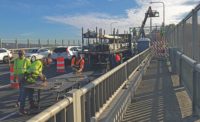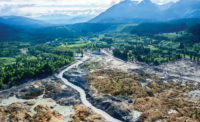ENR Northwest's 2018 Best Projects
Small Project (Under $10 Million) Best Project: Reduction Oxidation Facility Roof Project

Decommissioned in 1969, the reduction oxidation facility at the Hanford Nuclear Site deteriorated over the years, making it vulnerable to high winds, severe weather and earthquakes.
PHOTO BY DAVID WYATT-LOFTICS LLC

Decommissioned in 1969, the reduction oxidation facility at the Hanford Nuclear Site deteriorated over the years, making it vulnerable to high winds, severe weather and earthquakes.
PHOTO BY LES HERNANDEZ-DGR


Reduction Oxidation Facility Roof Project
US Dept. of Energy – Hanford Site, Wash.
Best Project
Owner/ MEP Engineer: CH2M Hill Plateau Remediation Co.
Lead Design Firm: Meier Architecture Engineering
General Contractor: DGR Grant
Civil/Structural Engineer: CH2M Hill Inc.
Crane and Rigging Services: Barnhart Crane & Rigging
Decommissioned in 1969, the reduction oxidation facility at the Hanford Nuclear Site deteriorated over the years, making it vulnerable to high winds, severe weather and earthquakes. The roof project provided a new structure that integrated into the existing roof, strengthened the building and provided a weather barrier.
The existing 90-ft-high, 388-ft-long and 64-ft-wide roof area consists of six separate cast-in-place concrete roof slabs that range between 5 in. thick and 9 in. thick. The slabs are supported by a series of non-composite steel roof purlins (horizontal structural beams). The purlins are supported by 7-ft-deep steel roof trusses that clear span across the structure. The roof structure is supported by 8-in.-thick concrete bearing walls. The original roof design included five vertical expansion joints and a horizontal expansion joint between the underside of the roof slab and the top of the concrete bearing wall.
The roof was covered in 1986 with a roofing system consisting of a bottom layer of mineral insulation, a middle layer of EPDM synthetic rubber roofing membrane and a top layer of rock ballast that was surrounded by asbestos-containing material and metal edge flashing.
The team designed a structure that could be integrated into the thin concrete slab sections and could pin the horizontal expansion joint to the facility’s 8-in. concrete walls in order to increase stability. Paul Branson, project manager at CH2M Hill, says the project’s success was based on the team’s ability to use pre-engineered building elements and customize them to act as a new roof structure. “What made this truly unique was the adaptation of a standard component into a very unconventional building,” he says.
Pinning the expansion joint required precision core drilling to a depth of 36 in. into the bearing walls. More than 300 anchor holes were drilled and pinned. All of the anchor holes and pins were inspected and no rework was required.
The team also piloted a wearable and wireless body monitoring system measuring heart rate and body core temperatures. The system provided real-time data on how the work affected the field crews.





